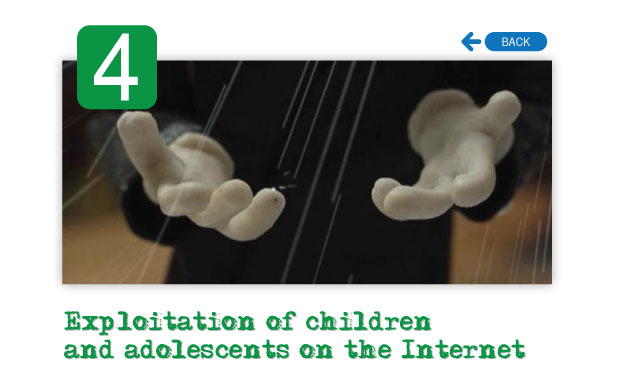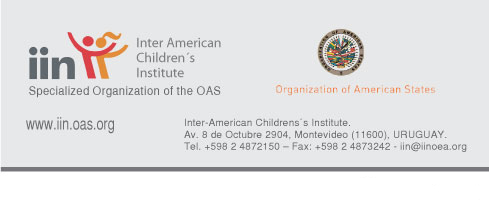| |
The Convention on the Rights of the Child (CRC) recognizes by Article 34 the right of children to protection from sexual violence, saying “States Parties undertake to protect the child from all forms of sexual exploitation and sexual abuse. For these purposes, States Parties shall in particular take all appropriate national, bilateral and multilateral measures to prevent: (a) The inducement or coercion of a child to engage in any unlawful sexual activity; (b) The exploitative use of children in prostitution or other unlawful sexual practices; (c) The exploitative use of children in pornographic performances and materials.”
Moreover, seeking to ensure the best achievement of the purposes of the CRC, the United Nations General Assembly adopted in 2000 the Optional Protocol to the Convention on the Rights of the Child on the sale of children, child prostitution and child pornography. In Article 2, paragraph c of this Protocol child pornography is defined as “any representation, by whatever means, of a child engaged in real or simulated explicit sexual activities or any representation of the sexual parts of a child for primarily sexual purposes.”
While the ratification of international standards is of great value and is due in justice, it is common to find that the judiciary fails in terms of national legislation. In this regard, we find in the region differences in how each country's legislators have defined the scope of this matter. The exploitation of children and adolescents in the field of information and communication technologies (ICT) has several edges and is very changeable, given the continuing technological advances.
Changes in the virtual environment
In the last 5 years not only the number of users and Internet coverage in the world have grown exponentially, but there are other technological advances that allow more material with sexual content to be available to more people. Among these developments can be listed: the increase in bandwidth and storage capacity, wireless Internet access even through mobile telephony, applications that allow sharing of videos and pictures instantly and with high quality, either files peer to peer or through social networks, among others.
As tools and platforms are developed that enable self-generation of content and the free exchange of information – that promotes so much the right to free expression of children - also in parallel it opens up a scenario in which sex offenders are more likely to share pictures and be in contact with children, in a way that was previously unknown.
Changes in terminology
Social applications and peer to peer have revolutionized the way in how Internet users communicate and share files. The new media have blurred the traditional differences between sexual abuse and commercial exploitation. The content of what is produced has changed and therefore the ongoing discussion on the terminology used to describe sexualized material (images, text and audio files) in relation to children.
It is worth considering this, as concerns about the language are not simply a matter of semantics, but the term used will have implications for all those interested in eradicating the continuous exploitation of children through the use of new technologies (Quayle, Loof, Palmer, 2008).
Considering this current reality, the definition provided by the Optional Protocol to the CRC developed in 2000, may be limited. It has been criticized the use of the term "child pornography" for the active nature that it involves, hiding in the Spanish language, the type of the boy victim or girl protagonist of the representation and the inability to consent such action. However, beyond the harmless criticism to the approach from which the matter is formulated, there is an expansion and diversification of the ways in which the rights of children can be violated through technology.
Changes in the phenomenon
The strong distinction between sexual abuse and commercial sexual exploitation is blurred in the context of ICTs. For example, children and adolescents abused at home, can produce images and sounds which then are commercialized. In the context of new technologies it is difficult to differentiate activities since the images "themselves become in a form of currency because, within the online community, they purchase certain status and act as a merchandise for trading. Once circulating on the Internet, they may end in a place where you have to pay to see them, where money changes hands” (Quayle, Loof, Palmer, 2008). This happens even in cases where the pictures were taken surreptitiously and the child does not know that they were published, commercialized and even, sometimes, produced.
The definition provided by the Optional Protocol to the CRC is certainly not limited to the visual representations. However, national laws often restrict the definition of "pornography" (bear in mind that this is the most widespread criminality in the region) to visual materials.
Considering the document of the Colombian Institute for Family Welfare (ICBF) to classify pornographic content, the following are the categories in which sexual exploitation of children and adolescents on the Internet is present:
• Visual: pictures, videos, films and cartoons. (In this last one the drawing is used to represent scenes of sex with children, accompanied by text which central argument is sex and violence).
• Audio: Messenger, audio-chats and video chats, among others, with sounds that suggest sexual activity involving children or adolescents, or people with voice or images of children.
• Text: stories, reports or testimonies. Many of these are part of "Letters from our readers" or "e-mails from our visitors," which are sent to various websites recounting own experiences, giving the appearance of situations experienced in reality which message is that it could happen again and that the reader could be the protagonist.
In any of the three formats abuses to children can be displayed, described or simulated abuses to children or situations of rape or incitement to sexual violence, etc. One aspect to be considered in preventive sensitization is that it is not strange to find that children or adolescents are presented as seducers of adults.
Restrictive definitions of the phenomenon can left out of understanding, research, the work of agencies responsible for enforcing the law as of those responsible for the protection of the rights of children and adolescents, some original situations. Just to name some of them we find:
- The use of the image of a child or adolescent in erotic contexts and/or abusive created by computer. When touching up the image, there is a child whose image was violated but not sexually abused.
- Creating animations with abusive images of children
- The use of self-generated images by children and that are available or are donated by the children
- The dissemination by other children of pictures with sexual content produced by themselves or others, with or without knowledge.
- Pornography conduced by adults, but that seem to be children or adolescents.
- The omission in the legislation of the criminalization of audio recordings in which children are used to give voice to sex scenes.
The variety of forms it has and also can assume the violation of children's rights to privacy and protection from sexual violence on the Internet worries the international community.
One indicator of this concern is the importance that was given to this matter at the Third World Congress on Sexual Exploitation of Children and Adolescents, that was held in Brazil in November 2008. This Congress not only mobilized especially the Inter-American region, but brought together the commercial and noncommercial forms of sexual exploitation in a single event, placing sexual violence in the framework of all forms of violence against children.
Bibliography:
-
Baines, V. (2008). El abuso sexual de menores en Internet: soluciones a través de la utilización de las leyes. Jaap Doek (Editor de la Serie) Presentado por ECPAT International en el III Congreso Mundial contra la ESNNA. Disponible en: http://www.ecpat.net/WorldCongressIII/PDF/Publications/ICT_Law/
Thematic_Paper_ICTLAW_SPA.pdf
-
ECPAT International (2008). Child Abuse Images and Sexual Exploitation of Children Online. Preparatory Expert Meeting for the World Congress III against Sexual Exploitation of Children and Adolescents. Bangkok, Thailand. Disponible en: http://www.ecpat.net/WorldCongressIII/PDF/Publications/ICT_meeting_Report.pdf
-
Instituto Colombiano de Bienestar Familiar (2004). Criterios de clasificación de páginas en Internet con contenidos de pornografía infantil. Colombia. ISBN 958-623-066-X
-
Quayle, Loof, Palmer (2008). El uso de niños, niñas y adolescentes en pornografía y la explotación sexual de menores en Internet. Jaap Doek (Editor de la Serie) Presentado por ECPAT International en el III Congreso Mundial contra la ESNNA. Disponible en: http://www.ecpat.net/WorldCongressIII/PDF/Publications/ICT_Psychosocial/
Thematic_Paper_ICTPsy_SPA.pdf
-
Lemineur (2006) El combate contra la pornografía infantil en Internet: el caso de Costa Rica. OIT/IPEC, Costa Rica.
-
Naciones Unidas (1989): Convención sobre los Derechos del Niño.
- Naciones Unidas (2000): Protocolo Facultativo de la Convención sobre los Derechos del Niño relativo a la venta de niños, la prostitución infantil y la utilización de los niños en la pornografía.
Link of interest:
Argentina
Brasil
Canadá
Colombia
Estados Unidos de América
Iniciativas Internacionales a tener en cuenta:
|
|
|

